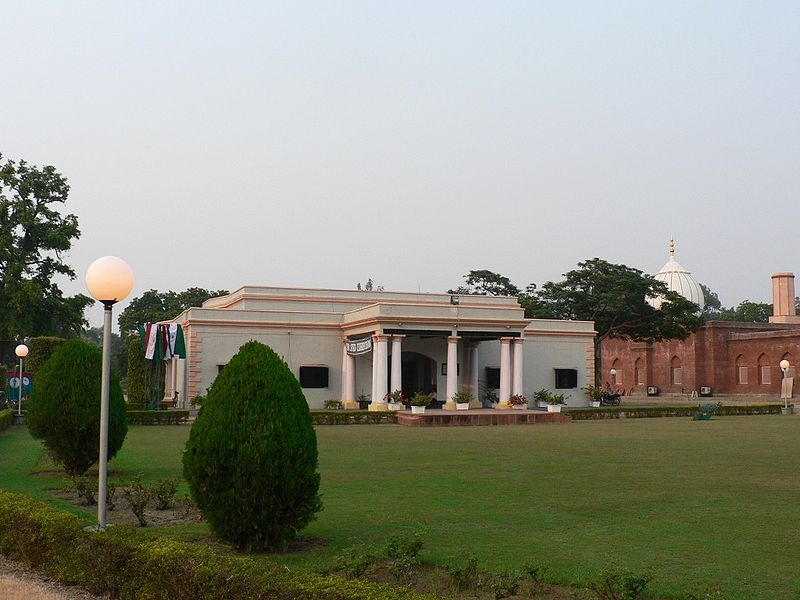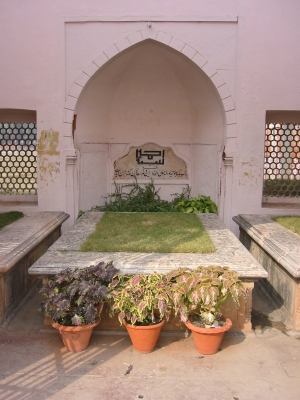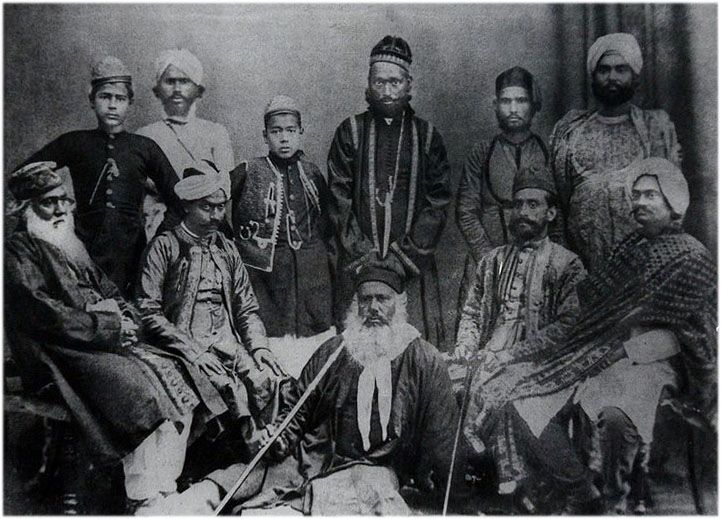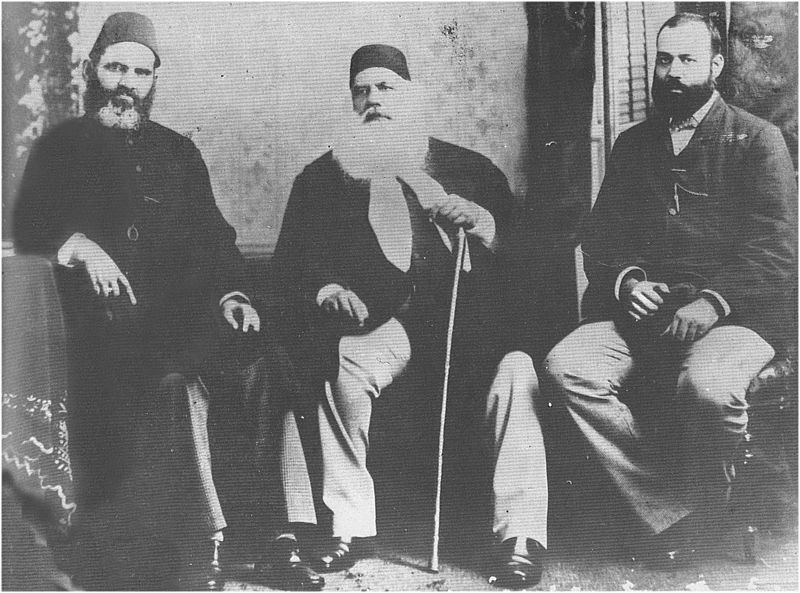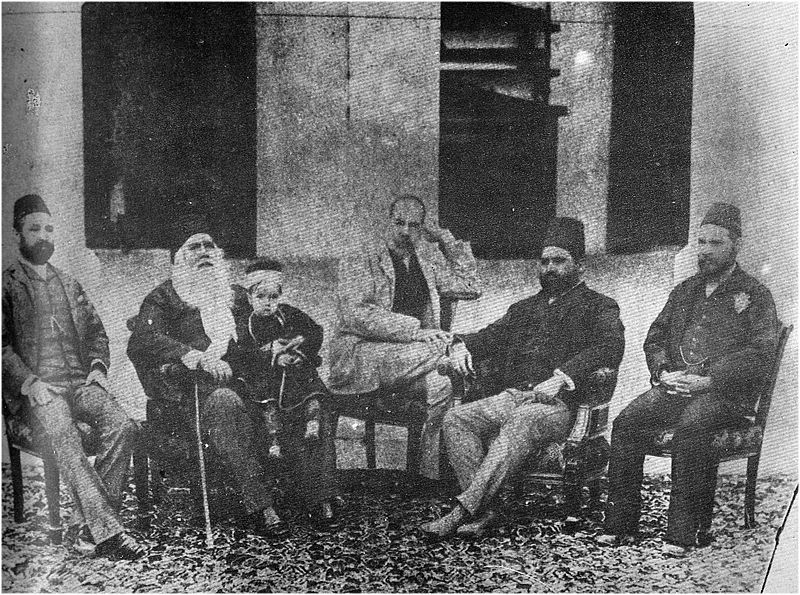<Back to Index>
- Mathematician Friedrich Ernst Peter Hirzebruch, 1927
- Writer Nathanael West (Nathan von Wallenstein Weinstein), 1903
- Politician and Islamic Reformer Syed Ahmed Khan, 1817
PAGE SPONSOR
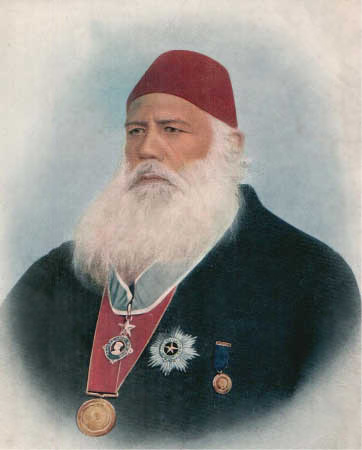
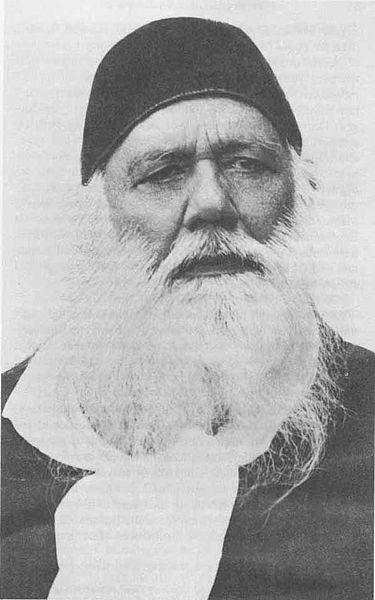
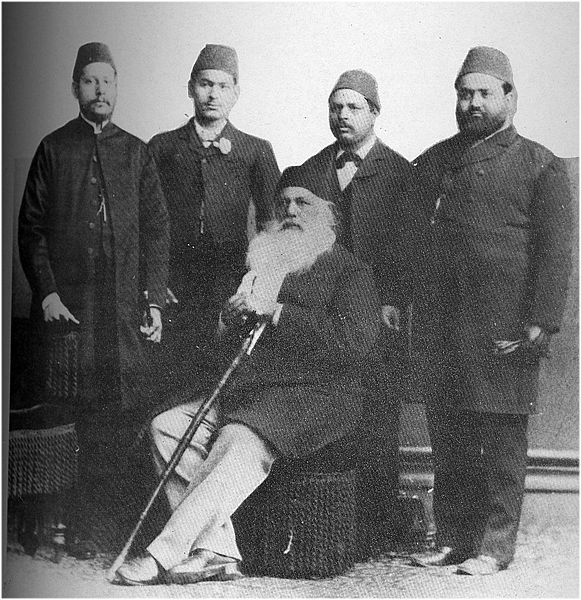
Javad-ud Daula, Arif Jang, Sir Syed Ahmed Khan, KCSI (also Sayyid Ahmad Khan) (Urdu:سید احمد خان) (October 17, 1817 – March 27, 1898), commonly known as Sir Syed, was an Indian educator and politician, and an Islamic reformer and modernist. Sir Syed pioneered modern education for the Muslim community in India by founding the Muhammedan Anglo - Oriental College, which later developed into the Aligarh Muslim University. His work gave rise to a new generation of Muslim intellectuals and politicians who composed the Aligarh movement to secure the political future of Muslims of India.
In 1842, Emperor Bahadur Shah Zafar II revived upon Syed Ahmad Khan the title of Javad-ud Daulah, conferred upon Syed Ahmad’s grandfather Syed Hadi by Emperor Shah Alam II in about the middle of the 18th century. The Emperor added to it the additional title of Arif Jang. The conferment of these titles was symbolic of Syed Ahmad Khan’s incorporation into the nobility of Delhi.
Born into Muslim nobility, Sir Syed earned a reputation as a distinguished scholar while working as a jurist for the British East India Company. During the Indian Rebellion of 1857 he remained loyal to the British and was noted for his actions in saving European lives. After the rebellion he penned the booklet Asbab - e - Baghawat - e - Hind (The Causes of the Indian Mutiny) — a daring critique, at the time, of British policies that he blamed for causing the revolt. Believing that the future of Muslims was threatened by the rigidity of their orthodox outlook, Sir Syed began promoting Western style scientific education by founding modern schools and journals and organising Muslim intellectuals. Towards this goal, Sir Syed founded the Muhammedan Anglo - Oriental College in 1875 with the aim of promoting social and economic development of Indian Muslims.
One of the most influential Muslim politicians of his time, Sir Syed was suspicious of the Indian independence movement and called upon Muslims to loyally serve the British Raj. He denounced nationalist organisations such as the Indian National Congress, instead forming organisations to promote Muslim unity and pro-British attitudes and activities. Sir Syed promoted the adoption of Urdu as the lingua franca of all Indian Muslims, and mentored a rising generation of Muslim politicians and intellectuals. Although hailed as a great Muslim leader and social reformer, Sir Syed remains the subject of controversy for his views on Hindu - Muslim issues.
Syed Ahmed Khan was born in Delhi, then the capital of the Mughal Empire. His family is said to have migrated from Herat (now in Afghanistan) in the time of emperor Akbar, although by other accounts his family descended from Arabia.
Many generations of his family had since been highly connected with the
Mughal administration. His maternal grandfather Khwaja Fariduddin
served as wazir in the court of Akbar Shah II. His paternal grandfather Syed Hadi held a mansab, a high - ranking administrative position and the honorary name of Jawwad Ali Khan in the court of Alamgir II. Sir Syed's father Mir Muhammad Muttaqi was personally close to Akbar Shah II and served as his personal adviser. However,
Sir Syed was born at a time when rebellious governors, regional
insurrections and the British colonialism had diminished the extent and
power of the Mughal state, reducing its monarch to a figurehead status.
With his elder brother Syed Muhammad Khan, Sir Syed was raised in a
large house in a wealthy area of the city. They were raised in strict
accordance with Mughal noble traditions and exposed to politics. Their
mother Azis - un - Nisa played a formative role in Sir Syed's life, raising
him with rigid discipline with a strong emphasis on education. Sir
Syed was taught to read and understand the Qur'an by a female tutor,
which was unusual at the time. He received an education traditional to
Muslim nobility in Delhi. Under the charge of Hamiduddin, Sir Syed was
trained in Persian, Arabic, Urdu and religious subjects. He read the works of Muslim scholars and writers such as Sahbai, Rumi and Ghalib. Other tutors instructed him in mathematics, astronomy and Islamic jurisprudence. Sir Syed was also adept at swimming, wrestling and
other sports. He took an active part in the Mughal court's cultural
activities. His elder brother founded the city's first printing press in
the Urdu language along with the journal Sayyad - ul - Akbar. Sir Syed pursued the study of medicine for several years, but did not complete the prescribed course of study. Until the death of his father in 1838, Sir Syed had lived a life customary for an affluent young Muslim noble. Upon his father's death, he inherited the titles of his grandfather and father and was awarded the title of Arif Jung by the emperor Bahadur Shah Zafar. Financial
difficulties put an end to Sir Syed's formal education, although he
continued to study in private, using books on a variety of subjects. Sir
Syed assumed editorship of his brother's journal and rejected offers of
employment from the Mughal court.
Social reforms in the muslim society were initiated by Abdul Latif. he founded 'the mohommedan literary society, in Bengal. Sir Sayed Ahmad Khan established the mohammedan Anglo - Oriental collage. later, this institution came to be converted into the Aligrh Muslim University. He opposed the ignorance, superstitions and evil customs prevalent in the Muslim society. He firmly believed that the Muslim society would not progress without the acquisition of western education and science. Having recognised the steady decline in Mughal political power, Sir Syed entered the British East India Company's civil service. He was appointed serestadar at the courts of law in Agra, responsible for record keeping and managing court affairs. In 1840, he was promoted to the title of munshi. In 1858, he was appointed to a high - ranking post at the court in Muradabad, where he began working on his most famous literary work.
Acquainted with high - ranking British officials, Sir Syed obtained close knowledge about British colonial politics during his service at the courts. At the outbreak of the Indian rebellion, on May 10, 1857, Sir Syed was serving as the chief assessment officer at the court in Bijnor. Northern India became the scene of the most intense fighting. The conflict had left large numbers of civilians dead. Erstwhile centres of Muslim power such as Delhi, Agra, Lucknow and Kanpur were severely affected. Sir Syed was personally affected by the violence and the ending of the Mughal dynasty amongst many other long standing kingdoms. Sir Syed and many other Muslims took this as a defeat of Muslim society. He lost several close relatives who died in the violence. Although he succeeded in rescuing his mother from the turmoil, she died in Meerut, owing to the privations she had experienced.
In 1859 Sir Syed Published the booklet Asbab - e - Bhaghawath - e - Hind,(The Causes of the Indian Revolt), in which he studied the causes of the revolt. In
this, his most famous work, he rejected the common notion that the
conspiracy was planned by Muslim élites, who were insecure at the
diminishing influence of Muslim monarchs. Sir
Syed blamed the British East India Company for its aggressive expansion
as well as the ignorance of British politicians regarding Indian
culture. However, he gained respect for British power, which he felt
would dominate India for a long period of time. Seeking to rehabilitate
Muslim political influence, Sir Syed advised the British to appoint
Muslims to assist in administration.
Maulana Altaf Hussain Hali wrote, "As soon as Sir Sayyid reached Muradabad, he began to write the pamphlet entitled The Causes of the Indian Revolt, in which he did his best to clear the people of India, and especially the Muslims, of the charge of Mutiny. In spite of the obvious danger, he made a courageous and thorough report of the accusations people were making against the Government and refuted the theory which the British had invented to explain the causes of the Mutiny.
When the work was finished, without waiting for an English translation, Sir Sayyid sent the Urdu version to be printed at the Mufassilat Gazette Press in Agra. Within a few weeks, he received 500 copies back from the printers. His friend warned him not to send the pamphlet to Parliament or to the Government of India. Master Ramchandra's younger brother, Rae Shankar Das, who was munsif in Muradabad and a great friend of Sir Sayyid, begged him to burn the books rather than put his life in danger. Sir Sayyid replied that he was bringing these matters to the attention of the British for the good of his own people, of his country, and of the Government itself. He said that if he came to any harm while doing something that would greatly benefit the rulers and the subjects of India alike, he would gladly suffer whatever befell him. When Rae Shankar Das saw that Sir Sayyid's mind was made up and nothing could be done to change it, he wept and remained silent. After performing a supplementary prayer and asking God's blessing, Sir Sayyid sent almost all the 500 copies of his pamphlet to England, one to the Government, and kept the rest himself.
When the Government of India had the book translated and presented before the Council, Lord Canning, the Governor - General, and Sir Barthold Frere both accepted it as a sincere and friendly report. The Foreign Secretary, however, severely attacked it, calling it 'an extremely seditious pamphlet'. He wanted a proper inquiry into the matter and said that the author, unless he could give a satisfactory explanation, should be harshly dealt with. Since no other member of the Council agreed with his opinion, his attack did no harm.
Later, Sir Sayyid was invited to attend Lord Canning's Durbar in Farrukhabad, and happened to meet the Foreign Secretary there. He told Sir Sayyid that he was displeased with the pamphlet and added that if he had really had the Government's interests at heart, he would not have made his opinion known in this way throughout the country, but would have communicated it directly to the Government. Sir Sayyid replied that he had only had five hundred copies printed, the majority of which he had sent to England, while one had been given to the Government of India, and the remaining copies were still in his possession. Furthermore, he had the receipt to prove it. He was aware, he added, that the view of the rulers had been distorted by the stress and anxieties of the times, which made it difficult to put even the most straightforward problem in its right perspective. It was for this reason that he had not communicated his thoughts publicly. He promised that for every copy that could be found circulating in India he would personally pay one thousand rupees. At first, the Foreign Secretary was not convinced, and asked Sir Sayyid over and over again if he was sure that no other copy had been distributed in India. Sir Sayyid reassured him on this matter, and the Foreign Secretary never mentioned it again. Later he became one of Sir Sayyid's strongest supporters.
Many
official translations were made of the Urdu text of The Causes of the
Indian Revolt. The one undertaken by the India Office formed the subject
of many discussions and debates. The
pamphlet was also translated by the Government of India and several
members of parliament, but no version was offered to the public. A
translation which has been started by a Government official was finished
by Sir Sayyid's great friend, Colonel G.F.I. Graham, and finally
published in 1873."
In 1855, he finished his highly scholarly, very well researched and illustrated edition of Abul Fazl’s Ai’n-e Akbari, itself an extraordinarily difficult book. Having finished the work to his satisfaction, and believing that Mirza Asadullah Khan Ghalib was a person who would appreciate his labours, Syed Ahmad approached the great Ghalib to write a taqriz (in the convention of the times, a laudatory foreword) for it. Ghalib obliged, but what he did produce was a short Persian poem castigating the Ai’n-e Akbari, and by implication, the imperial, sumptuous, literate and learned Mughal culture of which it was a product. The least that could be said against it was that the book had little value even as an antique document. Ghalib practically reprimanded Syed Ahmad Khan for wasting his talents and time on dead things. Worse, he praised sky - high the “sahibs of England” who at that time held all the keys to all the a’ins in this world.
This poem is often referred to but has never been translated to English. Shamsur Rahman Faruqi wrote an English translation. The translation is accurate if lacking the felicity of the original:
Good news my friends, this ancient book’s door
Is now open, because of the Syed’s grace and fortune, 1
The eye began to see, the arm found strength
That which was wrapped in ancient clothes,
now put on a new dress. 2
And this idea of his, to establish its text and edit the A’in
Puts to shame his exalted capability and potential, 3
He put his heart to a task and pleased himself
And made himself an auspicious, free servant. 4
One who isn’t capable of admiring his quality
Would no doubt praise him for this task, 5
For such a task, of which this book is the basis
Only an hypocrite can offer praise. 6
I, who am the enemy of pretence
And have a sense of my own truthfulness, 7
If I don’t give him praise for this task
It’s proper that I find occasion to praise. 8
I have nothing to say to the perverse
None know what I know of arts and letters, 9
In the whole world, this merchandise has no buyer.
What profit could my Master hope from it? 10
It should be said, it’s an excellent inventory
So what’s there to see that’s worth seeing? 11
And if you talk with me of Laws and Rules
Open your eyes, and in this ancient halting-place 12
Look at the Sahibs of England.
Look at the style and practice of these, 13
See what Laws and Rules they have made for all to see
What none ever saw, they have produced. 14
Science and skills grew at the hands of these skilled ones
Their efforts overtook the efforts of the forebears. 15
This is the people that own the right to Laws and Rules
None knows to rule a land better than they, 16
Justice and Wisdom they’ve made as one
They have given hundreds of laws to India. 17
The fire that one brought out of stone
How well these skilled ones bring out from straw! 18
What spell have they struck on water
That a vapour drives the boat in water! 19
Sometimes the vapour takes the boat down the sea
Sometimes the vapour brings down the sky to the plains. 20
Vapour makes the sky-wheel go round and round
Vapour is now like bullocks, or horses. 21
Vapour makes the ship speed
Making wind and wave redundant. 22
Their instruments make music without the bow
They make words fly high like birds: 23
Oh don’t you see that these wise people
Get news from thousands of miles in a couple of breaths? 24
They inject fire into air
And the air glows like embers, 25
Go to London, for in that shining garden
The city is bright in the night, without candles. 26
Look at the businesses of the knowledgeable ones:
In every discipline, a hundred innovators! 27
Before the Laws and Rules that the times now have
All others have become things of yesteryears, 28
Wise and sensitive and prudent one, does your book
Have such good and elegant Laws? 29
When one sees such a treasure house of gems
Why should one glean corn from that other harvest? 30
Well, if you speak of its style, it’s good
No, it’s much better than all else that you seek 31
But every good always has a better too
If there’s a head, there’s also a crown for it. 32
Don’t regard that Generous Source as niggardly
It’s a Date-Palm which drops sweet light, like dates. 33
Worshipping the Dead is not an auspicious thing
And wouldn’t you too think that it’s
no more than just words? 34
The Rule of silence pleases my heart, Ghalib
You spoke well doubtless, not speaking is well too. 35
Here in this world your creed is to worship all the
Prophet’s children,
Go past praising, your Law asks you to pray: 36
For Syed Ahmad Khan-e Arif Jang
Who is made up entirely of wisdom and splendour 37
Let there be from God all that he might wish for
Let an auspicious star lead all his affairs. 38
The
poem was unexpected, but it came at the time when Syed Ahmad Khan’s
thought and feelings themselves were inclining toward change. Ghalib
seemed to be acutely aware of a European [English] - sponsored change in
world polity, especially Indian polity. Syed Ahmad might well have been
piqued at Ghalib’s admonitions, but he would also have realized that
Ghalib’s reading of the situation, though not nuanced enough, was
basically accurate. Syed Ahmad Khan may also have felt that he, being
better informed about the English and the outside world, should have
himself seen the change that now seemed to be just round the corner. Sir Syed Ahmad Khan never again wrote a word in praise of the Ai’n-e Akbari and in fact gave up taking active interest in history and archaeology, and became a social reformer.
While continuing to work as a jurist, Sir Syed began focusing on writing, from the age of 23 (in 1840), on various subjects (from mechanics to educational issues), mainly in Urdu, where he wrote, at least, 6000 pages. His career as an author began when he published a series of treatises in Urdu on religious subjects in 1842. He published the book A'thar - as - sanadid (Great Monuments) documenting antiquities of Delhi dating from the medieval era. This work earned him the reputation of a cultured scholar. In 1842, he completed the Jila - ul - Qulub bi Zikr - il Mahbub and the Tuhfa - i - Hasan, along with the Tahsil fi jar-i-Saqil in 1844. These works focused on religious and cultural subjects. In 1852, he published the two works Namiqa dar bayan masala tasawwur - i - Shaikh and Silsilat ul-Mulk. He released the second edition of A'thar - as - sanadid in 1854. He also penned a commentary on the Bible — the first by a Muslim — in which he argued that Islam was the closest religion to Christianity, with a common lineage from Abrahamic religions. His other writings such as Loyal Muhammadans of India, Tabyin - ul - Kalam and A Series of Essays on the Life of Muhammad and Subjects Subsidiary Therein helped to create cordial relations between the British authorities and the Muslim community.
Throughout
his life Syed Ahmad found time for literary and Scholarly pursuits. The
range of his literary and Scholarly interests was very wide: history,
politics, archaeology, journalism, literature, religion and science.
Through the 1850s, Syed Ahmed Khan began developing a strongest passion for education. While pursuing studies of different subjects including European [jurisprudence], Sir Syed began to realise the advantages of Western style education, which was being offered at newly established colleges across India. Despite being a devout Muslim, Sir Syed criticised the influence of traditional dogma and religious orthodoxy, which had made most Indian Muslims suspicious of British influences. Sir Syed began feeling increasingly concerned for the future of Muslim communities. A scion of Mughal nobility, Sir Syed had been reared in the finest traditions of Muslim élite culture and was aware of the steady decline of Muslim political power across India. The animosity between the British and Muslims before and after the rebellion (Independence War) of 1857 threatened to marginalise Muslim communities across India for many generations. Sir Syed intensified his work to promote co-operation with British authorities, promoting loyalty to the Empire amongst Indian Muslims. Committed to working for the upliftment of Muslims, Sir Syed founded a modern madrassa in Muradabad in 1859; this was one of the first religious schools to impart scientific education. Sir Syed also worked on social causes, helping to organise relief for the famine - struck people of the North - West Frontier Province in 1860. He established another modern school in Ghazipur in 1863.
Upon his transfer to Aligarh in 1864, Sir Syed began working wholeheartedly as an educator. He founded the Scientific Society of Aligarh, the first scientific association of its kind in India. Modelling it after the Royal Society and the Royal Asiatic Society, Sir Syed assembled Muslim scholars from different parts of the country. The Society held annual conferences, disbursed funds for educational causes and regularly published a journal on scientific subjects in English and Urdu. Sir Syed felt that the socio - economic future of Muslims was threatened by their orthodox aversions to modern science and technology. In face of pressure from religious Muslims, Sir Syed avoided discussing religious subjects in his writings, focusing instead on promoting education.
On
the pre-colonial system he said "The rule of the former emperors and
rajas was neither in accordance with the Hindu nor the Mohammadan
religion. It was based on nothing but tyranny and oppression; the law of
might was that of right; the voice of the people was not listened to".
The onset of the Hindi - Urdu controversy of 1867 saw the emergence of Sir Syed as a political leader of the Muslim community. He became a leading Muslim voice opposing the adoption of Hindi as a second official language of the United Provinces (now Uttar Pradesh). Sir Syed perceived Urdu as the lingua franca of Muslims. Having been developed by Muslim rulers of India, Urdu was used as a secondary language to Persian, the official language of the Mughal court. Since the decline of the Mughal dynasty, Sir Syed promoted the use of Urdu through his own writings. Under Sir Syed, the Scientific Society translated Western works only into Urdu. The schools established by Sir Syed imparted education in the Urdu medium. The demand for Hindi, led largely by Hindus, was to Sir Syed an erosion of the centuries - old Muslim cultural domination of India. Testifying before the British - appointed education commission, Sir Syed controversially exclaimed that "Urdu was the language of gentry and Hindi that of the vulgar." His remarks provoked a hostile response from Hindu leaders, who unified across the nation to demand the recognition of Hindi.
The success of the Hindi movement led Sir Syed to further advocate Urdu as the symbol of Muslim heritage and as the language of all Indian Muslims. His educational and political work grew increasingly centred around and exclusively for Muslim interests. He also sought to persuade the British to give Urdu extensive official use and patronage. His colleagues such as Mohsin - ul - Mulk and Maulvi Abdul Haq developed organisations such as the Urdu Defence Association and the Anjuman Taraqqi - i - Urdu, committed to the perpetuation of Urdu. All these colleagues led efforts that resulted in the adoption of Urdu as the official language of the Hyderabad State and as the medium of instruction in the Osmania University. To Muslims in northern and western India, Urdu had become an integral part of political and cultural identity. However, the division over the use of Hindi or Urdu further provoked communal conflict between Muslims and Hindus in India.
On April 1, 1869 he went, along with his son Syed Mahmood, to England, where he was awarded the Order of the Star of India from the British government on August 6. Travelling across England, he visited its colleges and was inspired by the culture of learning established after the Renaissance. Sir Syed returned to India in the following year determined to build a "Muslim Cambridge." Upon his return, he organised the "Committee for the Better Diffusion and Advancement of Learning among Muhammadans" (Muslims) on December 26, 1870. Sir Syed described his vision of the institution he proposed to establish in an article written sometime in 1872 and re-printed in the Aligarh Institute Gazette of April 5, 1911:
I may appear to be dreaming and talking like Shaikh Chilli, but we aim to turn this MAO College into a University similar to that of Oxford or Cambridge. Like the churches of Oxford and Cambridge, there will be mosques attached to each College… The College will have a dispensary with a Doctor and a compounder, besides a Unani Hakim. It will be mandatory on boys in residence to join the congregational prayers (namaz) at all five times. Students of other religions will be exempted from this religious observance. Muslim students will have a uniform consisting of a black alpaca, half - sleeved chugha and a red Fezcap… Bad and abusive words which boys generally pick up and get used to, will be strictly prohibited. Even such a word as a "liar" will be treated as an abuse to be prohibited. They will have food either on tables of European style or on chaukis in the manner of the Arabs… Smoking of cigarette or huqqa and the chewing of betels shall be strictly prohibited. No corporal punishment or any such punishment as is likely to injure a student's self - respect will be permissible… It will be strictly enforced that Shia and Sunni boys shall not discuss their religious differences in the College or in the boarding house. At present it is like a day dream. I pray to God that this dream may come true."
By
1873, the committee under Sir Syed issued proposals for the
construction of a college in Aligarh. He began publishing the journal Tahzib al-Akhlaq (Social Reformer) to spread awareness and knowledge on modern subjects and promote reforms in Muslim society. Sir
Syed worked to promote reinterpretation of Muslim ideology in order to
reconcile tradition with Western education. He argued in several books
on Islam that the Qur'an rested on an appreciation of reason and natural
law, making scientific inquiry important to being a good Muslim. Sir
Syed established a modern school in Aligarh and, obtaining support from
wealthy Muslims and the British, laid the foundation stone of the
Muhammadan Anglo - Oriental College on May 24, 1875. He retired from his
career as a jurist the following year, concentrating entirely on
developing the college and on religious reform. Sir
Syed's pioneering work received support from the British. Although
intensely criticised by orthodox religious leaders hostile to modern
influences, Sir Syed's new institution attracted a large student body,
mainly drawn from the Muslim gentry and middle classes. The curriculum
at the college involved scientific and Western subjects, as well as
Oriental subjects and religious education. The first chancellor was Sultan Shah Jahan Begum, a prominent Muslim noblewoman, and Sir Syed invited an Englishman, Theodore Beck, to serve as the first college principal. The college was originally affiliated with Calcutta University but was transferred to the Allahabad University in
1885. Near the turn of the 20th century, it began publishing its own
magazine and established a law school. In 1920, the college was
transformed into a university.
In 1878, Sir Syed was nominated to the Viceroy's Legislative Council. He testified before the education commission to promote the establishment of more colleges and schools across India. In the same year, Sir Syed founded the Muhammadan Association to promote political co-operation amongst Indian Muslims from different parts of the country. In 1886, he organised the All India Muhammadan Educational Conference in Aligarh, which promoted his vision of modern education and political unity for Muslims. His works made him the most prominent Muslim politician in 19th century India, often influencing the attitude of Muslims on various national issues. He supported the efforts of Indian political leaders Surendranath Banerjea and Dadabhai Naoroji to obtain representation for Indians in the government and civil services. In 1883, he founded the Muhammadan Civil Service Fund Association to encourage and support the entry of Muslim graduates into the Indian Civil Service (ICS). While fearful of the loss of Muslim political power owing to the community's backwardness, Sir Syed was also averse to the prospect of democratic self - government, which would give control of government to the Hindu - majority population:
"At this time our nation is in a bad state in regards education and wealth, but God has given us the light of religion and the Quran is present for our guidance, which has ordained them and us to be friends. Now God has made them rulers over us. Therefore we should cultivate friendship with them, and should adopt that method by which their rule may remain permanent and firm in India, and may not pass into the hands of the Bengalis… If we join the political movement of the Bengalis our nation will reap a loss, for we do not want to become subjects of the Hindus instead of the subjects of the "people of the Book…"
Sir
Syed Ahmed Khan lived the last two decades of his life in Aligarh,
regarded widely as the mentor of 19th and 20th century Muslim
intellectuals and politicians. He remained the most influential Muslim
politician in India, with his opinions guiding the convictions of a
large majority of Muslims. Battling illnesses and old age, Sir Syed died on March 27, 1898. He was buried besides Sir Syed Masjid inside the campus of the Aligarh university. His funeral was attended by
thousands of students, Muslim leaders and British officials. Sir Syed is
widely commemorated across South Asia as a great Muslim reformer and
visionary.
At the same time, Sir Syed sought to politically ally Muslims to the British government. An avowed loyalist of the British Empire, Sir Syed was nominated as a member of the Civil Service Commission in 1887 by Lord Dufferin. In 1888, he established the United Patriotic Association at Aligarh to promote political co-operation with the British and Muslim participation in the government. Syed Ahmed Khan was knighted by the British government in 1888 and in the following year he received an LL.D. honoris causa from Edinburgh University.
The university he founded remains one of India's most prominent institutions. Prominent alumni of Aligarh include Muslim political leaders Maulana Mohammad Ali, Abdur Rab Nishtar, Maulana Shaukat Ali and Maulvi Abdul Haq, who is hailed in Pakistan as Baba - e - Urdu (Father of Urdu). The first two Prime Ministers of Pakistan, Liaquat Ali Khan and Khawaja Nazimuddin, as well as the late Indian President Dr. Zakir Hussain, are amongst Aligarh's most famous graduates. In India, Sir Syed is commemorated as a pioneer who worked for the socio - political upliftment of Indian Muslims, Sir Syed is also hailed as a founding father of Pakistan for his role in developing a Muslim political class independent of Hindu - majority organisations. The Sir Syed University of Engineering and Technology was established in honour of Sir Syed in Karachi and is a leading technical institution in Pakistan. Furthermore, Sir Syed Government Girls College in Karachi, Pakistan, is also named in honour of Sir Syed Ahmed Khan. Today he has family living in Denmark, India, Pakistan and UK.
Supporters
of Sir Syed contend that his political vision gave an independent
political expression to the Muslim community, which aided its goal of
securing political power in India. His philosophy guided the creation of the All India Muslim League
in 1906, as a political party separate from the Congress. Sir Syed's
ideas inspired both the liberal, pro-British politicians of the Muslim
League and the religious ideologues of the Khilafat struggle.
The Muslim League remained at odds with the Congress and continued to
advocate the boycott of the Indian independence movement. In the 1940s,
the student body of Aligarh committed itself to the establishment of
Pakistan and contributed in large measure to the activities of the
Muslim League. Sir Syed's patronage of Urdu led to its widespread use amongst Indian Muslim communities and following the Partition of India its adoption as the official language of Pakistan, even though Bengali and Punjabi were more prevalent at the time.
